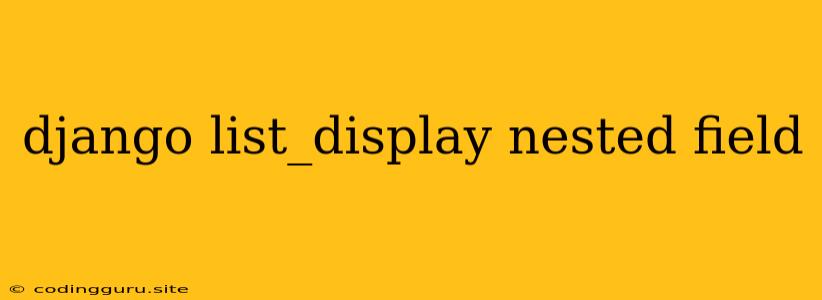Displaying Nested Fields in Django Admin: A Comprehensive Guide
Django's admin interface is a powerful tool for managing your data. It provides a user-friendly interface for creating, editing, and viewing your models. However, you might encounter a challenge when you want to display information from nested fields directly in the admin list view. This is where the list_display attribute combined with custom methods comes into play.
Understanding the Problem
Imagine you have a model structure where you want to display the name of a related object in the admin list view. For example, you have a Product model that has a Category model as a foreign key. You want to see the category name directly in the Product admin list instead of just the category ID.
The Solution: Utilizing list_display and Custom Methods
Django's list_display attribute is used to specify which fields should be shown in the admin list view. By default, it only displays the model's own fields. To display a field from a related model, we need to create a custom method that retrieves the desired value and add it to the list_display.
Step-by-Step Guide
Let's break down the process with a practical example:
-
Define your Models:
from django.db import models class Category(models.Model): name = models.CharField(max_length=100) def __str__(self): return self.name class Product(models.Model): name = models.CharField(max_length=200) category = models.ForeignKey(Category, on_delete=models.CASCADE) def __str__(self): return self.name -
Create a Custom Method: In your
Productmodel, add a method to retrieve the category name:def get_category_name(self): return self.category.name -
Update
list_displayin Admin: In youradmin.py, modify theProductAdminclass:from django.contrib import admin from .models import Product class ProductAdmin(admin.ModelAdmin): list_display = ('name', 'get_category_name') admin.site.register(Product, ProductAdmin) -
Run your Server: Now, when you access the
Productadmin list view, you'll see both thenameandcategory_namecolumns.
Important Points to Remember:
- Method Naming: The custom method used in
list_displayshould be named in the formatget_<field_name>. In this example,get_category_nameis used to retrieve the category name. - Field Type: The custom method must return a value of a type that can be displayed in the admin list view, typically a string or a number.
- Foreign Keys and Relationships: This technique works well with foreign keys and other relationships, allowing you to display information from related models.
Additional Tips:
- You can use
admin.displaydecorator to add custom formatting or behavior to yourlist_displayfields. - For more complex data structures, you can create custom methods to retrieve specific values from nested fields.
- You can also use custom methods to display calculated values, such as the total price of a product or the age of a user.
Example: Displaying a Product's Category with Additional Information
Let's extend the example further. Imagine you want to display the category name along with its description in the Product admin list view:
class ProductAdmin(admin.ModelAdmin):
list_display = ('name', 'get_category_display')
def get_category_display(self):
return f"{self.category.name} - {self.category.description}"
This example demonstrates how you can combine multiple values from related models and present them in a single list_display field.
Conclusion
By combining the list_display attribute with custom methods, you can effectively display nested fields and present your data in a more informative and user-friendly manner within the Django admin interface. This enhances the usability of the admin, enabling you to efficiently manage your data without needing to navigate through multiple pages or objects.
